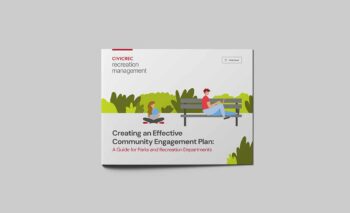Sustainable Parks, Smarter Spending: A Guide for Rec Leaders
Discover how park and rec departments can balance environmental and financial sustainability to build thriving, cost-effective spaces and programming.
Sustainability is essential for protecting the planet, but in parks and recreation, it goes far beyond just planting trees and recycling. While these efforts matter and help keep community spaces thriving, true sustainability also means making sure these spaces are financially sound.
As a parks and recreation professional, you’re responsible for managing the natural resources in your community and the budgets that keep them running. By providing places for residents to connect with nature, stay active, and create lasting memories — your parks department is well-positioned to lead in the way in sustainability.
The best part? Embracing sustainability doesn’t just protect the environment — it saves money. By making smart, sustainable choices, your department can stretch its budget further while increasing the value it brings to the community.
Keep reading for insights and practical steps to make your parks and recreation department more environmentally and financially sustainable.
Everything’s Coming Up Green: A Holistic Approach to Sustainability
Protecting the environment requires resources, meaning environmental sustainability and financial viability are directly linked. By balancing both, your department can create lasting impact while staying financially strong.
What is Environmental Sustainability?
Environmental sustainability in parks and recreation means responsibly managing natural spaces, resources, and facilities to ensure long-term ecological health. Adopting sustainable practices helps preserve biodiversity, lower your community’s carbon footprint, and maintain clean, safe, and resilient outdoor spaces.
Examples of Environmental Sustainability in Action
New York City’s Central Park Conservancy (the Conservancy) implemented a zero waste initiative to divert park waste from landfills by expanding recycling and composting programs. The Conservancy also uses green infrastructure, including rain gardens and permeable pavements, to manage stormwater runoff and prevent flooding. Across New York City parks, the transition to LED lighting and electric maintenance vehicles has significantly reduced the city’s carbon footprint.
In Austin, Texas, the city’s Climate Resilience Plan prioritizes tree planting, carbon sequestration, and sustainable landscaping. The city has also invested in smart irrigation technology, which adjusts watering schedules based on weather patterns to reduce water waste. Additionally, Austin’s “It’s My Park Day” is an annual volunteer event where the community comes together to support park cleanup, native plant restoration, and green conservation efforts.
Related Read: Cost Recovery: More Than Just Raising Fees – Here’s Evidence
The Link Between Financial Stability and Sustainability
Financial stability is the foundation of long-term environmental and operational sustainability in parks and recreation. Programs like those mentioned earlier require resources like money, time, people, and equipment to succeed. Without strong financial management, these initiatives wouldn’t be possible. Recent data supports this, finding that 79% of park and recreation agencies rely on operating budgets to fund sustainability measures, while 68% use capital budgets for the same purpose.
To achieve financial sustainability, your department must make strategic decisions aimed at reducing costs, increasing efficiency, and maintaining your department’s long-term financial health.
How to Build a Sustainable Future While Strengthening Your Budget
Creating a greener future while maintaining financial stability requires a smart, strategic approach to resource management. By making intentional choices, your parks and recreation department can reduce costs, improve efficiency, and enhance its environmental impact.
Keep reading for practical steps your department can take to prioritize environmental and financial sustainability.
5 Steps to Enhance Environmental Sustainability
- Be More Energy Efficient: Follow New York City’s lead by switching to LED lighting in parks and facilities. Upgrade to more energy-efficient HVAC systems and consider installing solar panels to cut energy costs and reduce your department’s carbon footprint.
- Conserve Water: Install low-flow water fixtures in public restrooms and concession stands. Use water-wise landscaping practices with drought-tolerant plants and implement smart irrigation systems to optimize water usage based on weather patterns.
- Reduce Waste: Make recycling easy by placing recycling bins in parks and community spaces. Encourage composting of organic waste and promote alternatives to single-use plastics.
- Protect Natural Habitats: Restore and maintain natural ecosystems within your parks by planting native trees and vegetation and creating pollinator gardens. Implement conservation plans to protect local wildlife and biodiversity.
- Make Transportation More Sustainable: Promote biking and walking by adding bike racks, pedestrian-safe paths, and car-free zones to parks and facilities. Advocate for reliable public transit schedules and routes to make sustainable commuting a practical option for residents.
5 Steps to Strengthen Financial Sustainability
- Reduce Costs: Cut utility expenses by lowering energy and water consumption in parks and public spaces. Effective recycling and composting programs can also minimize waste disposal costs, freeing funds for other sustainability initiatives.
- Boost Operational Efficiency: Use technology to streamline processes, such as online registration and payments, to save time, reduce paperwork, and lower administrative costs.
- Secure Grant Funding: Explore grant opportunities dedicated to sustainability projects. Many foundations and government agencies offer funding for initiatives that promote environmental stewardship and community well-being.
- Form Public-Private Partnerships: Collaborate with local businesses and organizations to support sustainability initiatives. Involving the community through sponsorships and donations can help secure necessary resources while boosting resident engagement.
- Use Life-Cycle Cost Analysis: When making purchase decisions, always consider the total cost of ownership, including maintenance, repairs, and replacement, not just the initial purchase price. Opt for durable, high-quality products that will last longer.
Watch the On-Demand Presentation: Transform Your Parks: A Guide to Community Engagement
Sustainable Practices: Balancing Environmental and Financial Responsibility
Sustainability — both environmental and financial — is a necessity for the ongoing success of park and recreation departments. By taking a holistic approach, you can create thriving, resilient spaces that benefit the planet and community for generations to come. And don’t forget: sustainable choices often lead to financial savings, making them a wise investment in your department’s future.
Now is the time to embrace sustainability and lead by example. By implementing these practices, maintaining environmental and financial responsibility, and educating the public, you can inspire your community to do the same — creating a lasting impact that extends far beyond your parks and facilities.
More Solutions for Municipal Recreation Planning and Management
Discover even more ways to improve recreation and add benefits to your community.


